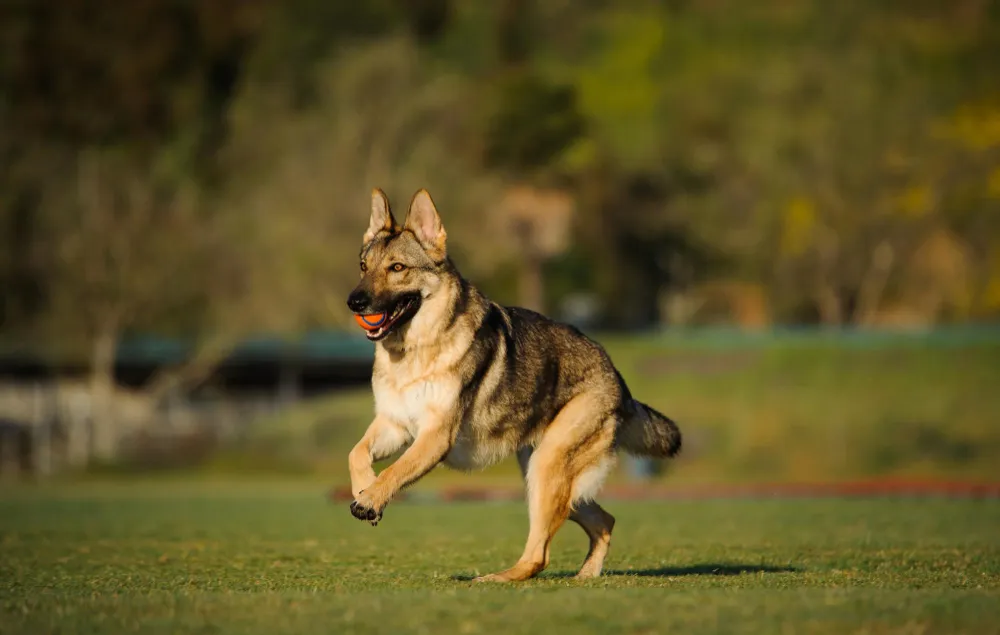If you’ve ever seen a German Shepherd take off running, you know, it’s a sight to behold. Powerful legs, focused eyes, and that smooth stride that makes you go, “Whoa, that dog’s fast!”
But exactly how fast can a German Shepherd dog run? What’s their top speed? And how slow do they go when they’re just trotting next to you on a casual walk? Whether you’re thinking of adopting one, already have one zooming around your yard, or just curious about what makes these dogs so athletic, this post is for you.
A bit of background first: The German Shepherd Dog (GSD) was originally bred in Germany in the late 1800s as a herding dog, known for both intelligence and agility. These traits weren’t just for show, they helped shepherds manage large flocks across rough terrain, requiring the dog to move quickly, react instantly, and work tirelessly. That working background plays a huge role in their athletic ability today. In fact, a dog’s breed history and genetics heavily affect how fast a dog can run, and with GSDs, it’s clear they were built for speed, strength, and stamina.
How Fast Can a German Shepherd Run?
German Shepherd is one of the fastest dog. A healthy adult German Shepherd’s running speed ranges from 25 to 30 miles per hour (40 to 48 kilometres per hour). While that’s amazing enough, some can go much farther and achieve short bursts of up to 32 mph (51 km/h).
To put it into perspective, that’s faster than most human athletes and more than enough to chase down a ball, a squirrel, or even keep up with a moving vehicle for short distances.
What About Their Minimum Speed?
Not every run is a race. When they’re just out for a walk, exploring the park, or lightly jogging next to you, German Shepherds typically move at a pace of around 5 to 8 mph (8 to 13 km/h). This is their comfortable, everyday “let’s stretch our legs” kind of speed.
This slower pace is more common in:
- Older or senior Shepherds
- Dogs recovering from injury
- Casual walks and light exercise
- Playtime in the backyard
What Influences a German Shepherd’s Speed?
1. Age
Just like humans, age plays a huge role in a dog’s physical performance. A young German Shepherd puppy might be full of energy, but they’re still developing their coordination and muscle strength. Adult Shepherds, typically between 2 and 6 years old, are in their prime running years. This is when they’re most agile, strong, and capable of reaching top speeds. On the other hand, senior Shepherds tend to slow down due to natural aging, joint stiffness, or health concerns, which can reduce both their speed and stamina.
2. Health & Fitness Level
A German Shepherd’s overall health and fitness are major speed factors. A well-conditioned dog with a healthy weight, strong muscles, and a good diet will naturally run faster than a dog that’s overweight, under-exercised, or dealing with medical issues. Conditions like hip or elbow dysplasia, common in the breed, can significantly limit mobility and running ability. Regular exercise, checkups, and proper nutrition help maintain your dog’s physical condition and support peak performance.
3. Genetics & Breeding
Not all German Shepherds are built exactly the same. Some are bred specifically for working roles, such as police and military, or herding work, which often means they have superior physical traits like speed, stamina, and agility. Others may come from show or companion lines, where appearance or temperament is prioritized over athletic ability. Genetics can influence everything from muscle tone to limb structure, hip dysplasia which ultimately affects how fast and efficiently a Shepherd can run.
4. Training & Physical Conditioning
Speed isn’t just natural—it’s also learned and built over time. A German Shepherd that’s trained for agility, obedience, or sporting competitions will be more agile, focused, and responsive during runs. Their bodies become conditioned to move quickly, change direction efficiently, and sustain a higher pace. Even casual training like daily walks, fetch, or jogs helps strengthen their endurance and improve their running ability. Without regular physical activity, even naturally athletic Shepherds can lose their edge.
5. Surface & Terrain
Where your dog runs matters more than you might think. Soft grass or dirt provides better traction and is gentler on the joints, allowing for smoother, faster runs. Hard surfaces like concrete can be uncomfortable or even harmful over time, while slippery floors (like tile or hardwood) can prevent proper grip and make your dog cautious, which slows them down. Uneven terrain, mud, or rocky trails can also affect both speed and safety during a run.
6. Weather & Climate
German Shepherds have thick double coats that protect them in cold weather, but they can overheat easily in hot or humid conditions. High temperatures can drain their energy, make them sluggish, and even lead to heatstroke if they’re overexerted. On the flip side, cool weather usually allows for longer and faster runs, especially when hydration is maintained. Always consider the climate and time of day before encouraging your Shepherd to run at high speeds.
How the Respiratory and Cardiovascular Systems Impact Dog Speed?
When it comes to how fast a dog can run, it’s not just about muscles and legs—the respiratory and cardiovascular systems play a huge role behind the scenes.
Respiratory System: Powering Every Breath
A German Shepherd’s lungs work overtime when they run. Their respiratory system is responsible for getting oxygen into the body, fueling the muscles during activity. The more efficiently a dog can take in air and deliver oxygen, the longer and faster they can run. Healthy lungs = better endurance and stronger performance.
Cardiovascular System: The Heart of the Race
The cardiovascular system includes the heart and blood vessels, which pump oxygen-rich blood to the working muscles. German Shepherds have strong, athletic hearts that keep their blood flowing even during intense activity. A healthy heart keeps their energy levels up and prevents fatigue from setting in too soon.
Together, these systems act like a high-performance engine, keeping the body cool, oxygenated, and ready to sprint. If either system is weak or compromised (due to age, illness, or lack of fitness), speed and stamina take a serious hit.
The German Shepherd Dog Max Speed Compared to Other Animals
| Animal | Top Speed | Notes |
|---|---|---|
| German Shepherd Dog | 30–32 mph (48–51 km/h) | Strong runner with great stamina—built for agility and endurance |
| Greyhound | 45 mph (72 km/h) | The fastest dog breed—designed for racing and sprinting |
| Cheetah | 60–70 mph (96–113 km/h) | Fastest land animal—but only for short bursts (20–30 seconds max) |
| Horse (Thoroughbred) | 40–44 mph (64–70 km/h) | Strong sprinters in races—also have high endurance |
| Domestic Cat | 30 mph (48 km/h) | Surprisingly quick in short bursts—great hunters |
| Human (Usain Bolt) | 27.8 mph (44.7 km/h) | Fastest recorded human sprint—only sustainable for a few seconds |
| Kangaroo | 35 mph (56 km/h) | Uses strong hind legs to leap fast over long distances |
| Lion | 50 mph (80 km/h) | Quick, powerful sprinter—but only for very short distances |
| Rabbit (Jackrabbit) | 45 mph (72 km/h) | Uses powerful hind legs for zig-zag speed to escape predators |
Can Human Outrun a German Shepherd Dog?
To put it briefly, the typical human is unable to outrun a German Shepherd.
In brief bursts, a healthy adult German Shepherd can run between 30 and 32 mph (48 and 51 km/h). In contrast, Usain Bolt, the fastest person in history, achieved a high speed of 27.8 mph (44.7 km/h) during a world-record sprint, but only for a brief period of time. While jogging, the average person runs at 5 to 8 mph (8 to 13 km/h), while during a full sprint, they may run at 12 to 15 mph. In a race against a German Shepherd, therefore, even the fastest of us would lose.
Top Fastest Dog Breeds In The World
1. Greyhound – 45 mph (72 km/h)
The undisputed speed champ of the dog world. Greyhounds are sleek, aerodynamic, and built for racing. Their long legs and flexible spine give them the ability to stretch out in a full sprint, making them the fastest dog breed on Earth.
2. Saluki – 42 mph (67 km/h)
Elegant and swift, the Saluki was bred for hunting in the deserts of the Middle East. They’re incredibly light on their feet and have the endurance to maintain high speeds over long distances.
3. Vizsla – 40 mph (64 km/h)
Known for their athleticism and affectionate nature, Vizslas are powerful yet graceful runners. They’re also highly trainable, making them great partners for runners and active families.
4. Afghan Hound – 40 mph (64 km/h)
Don’t let the flowing hair fool you, Afghan Hounds are nimble, lightning-fast sighthounds bred for chasing prey across rough terrain. Their agility and speed are as impressive as their looks.
5. Jack Russell Terrier – 38 mph (61 km/h)
Small but mighty! Jack Russells are full of energy and surprisingly fast for their size. Their short legs don’t hold them back—they’re incredibly quick, agile, and always up for a chase.
6. Dalmatian – 37 mph (60 km/h)
Originally bred to run alongside horse-drawn carriages, Dalmatians have great endurance and strong legs. Their speed and stamina make them excellent jogging companions.
7. Whippet – 35 mph (56 km/h)
Often called a “mini Greyhound,” Whippets are compact, agile, and just as fast over short distances. They’re perfect sprinters and love to zoom around open spaces.
8. Borzoi – 36 mph (58 km/h)
Also known as the Russian Wolfhound, the Borzoi is a graceful and speedy sighthound. With long legs and a slim build, they move with quiet power and elegance.
9. Doberman Pinscher – 32 mph (51 km/h)
Dobermans are known for their intelligence, strength, and athleticism. Their muscular build allows them to hit impressive speeds, especially when trained for protection or agility work.
10. German Shepherd – 30–32 mph (48–51 km/h)
A versatile working breed with great strength, endurance, and focus. German Shepherds may not be the absolute fastest, but their combination of speed and stamina makes them top performers in police, military, and agility fields.




